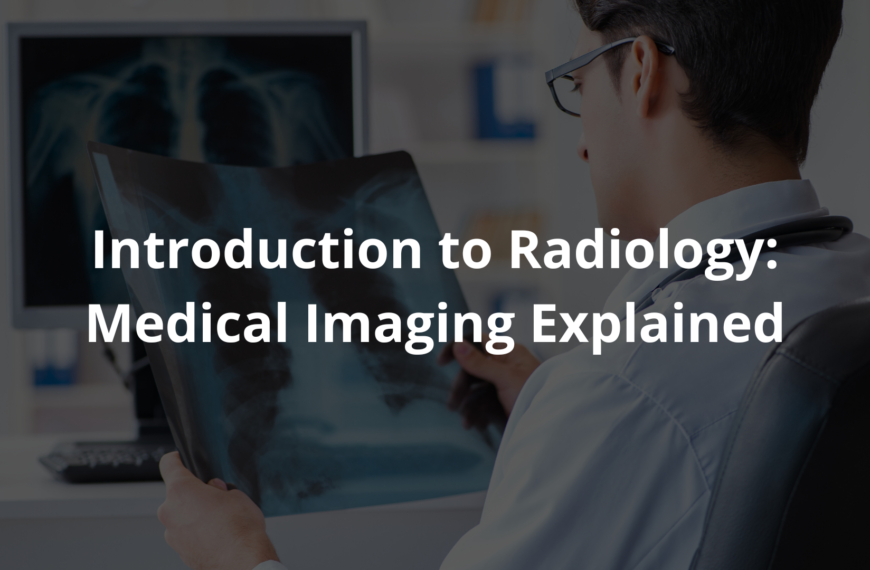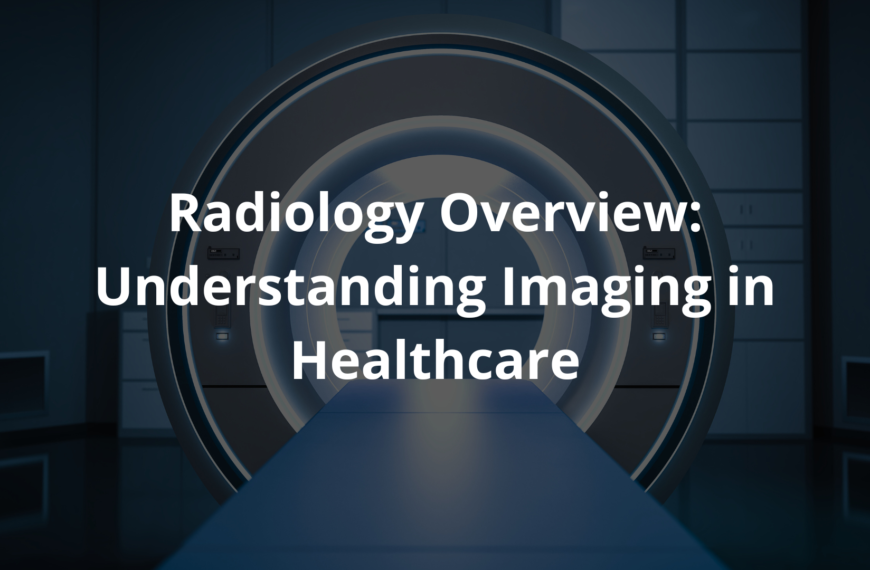Learn how radiology helps in diagnosing diseases, enhancing patient care, and managing risks through imaging techniques.
Radiology plays a crucial role in modern healthcare, offering insights into the body’s internal structures through imaging techniques like X-rays, CT scans, and MRIs. This article explains how radiology works, the technologies involved, and how it directly impacts patient care. Whether you’re new to medical imaging or looking for a deeper understanding, this guide will provide the essential knowledge.
Key Takeaways
- Radiology uses various imaging modalities (X-ray, CT, MRI, Ultrasound) for accurate diagnosis and treatment planning.
- Radiologists and technologists play key roles in operating equipment and ensuring patient safety during exams.
- Radiation safety protocols help minimise exposure and protect patients while ensuring diagnostic accuracy.
Key Radiological Modalities
Radiology plays a vital role in modern healthcare by utilising advanced imaging techniques to diagnose and evaluate various conditions. The major imaging modalities include X-ray, CT, MRI, and ultrasound, each with its strengths and purposes in clinical settings. (1)
X-ray Imaging
X-rays, one of the oldest diagnostic tools, play a crucial role in modern healthcare. They use ionising radiation to capture images of internal structures, with denser tissues like bones appearing bright white, while softer tissues like muscles and organs show up darker. This contrast makes it easy to detect bone fractures, joint dislocations, and certain lung conditions.
In emergency situations, X-rays are often the first test performed, providing quick insights to guide treatment. However, despite their common use, X-rays involve ionising radiation, which can increase the risk of cancer if used excessively.
To ensure safety:
- Radiologists follow strict protocols to assess whether imaging is necessary.
- Guidelines are in place to limit radiation exposure.
- Care is taken to minimise risks while still providing essential diagnostic information.
Understanding these measures can help ease concerns about X-ray safety while recognising its importance in healthcare.
Computed Tomography (CT)
CT scans, or CAT scans, use multiple X-ray images taken from various angles to create detailed cross-sectional images of the body. These scans can generate 3D models, offering a clear and comprehensive view of internal structures, making them invaluable for diagnosing complex conditions.
Key benefits of CT scans include:
- High-resolution images that help diagnose conditions like internal bleeding, organ injuries, and cancer.
- The ability to provide quick, detailed insights, especially in emergency situations.
However, there are some considerations:
- CT scans expose patients to higher levels of radiation compared to regular X-rays.
- As a result, CT scans are generally reserved for cases where detailed imaging is crucial.
In emergency scenarios, such as brain injuries from accidents, CT scans are essential for delivering fast and accurate results, making them an indispensable tool in urgent care and complex diagnostics.
Magnetic Resonance Imaging (MRI)
MRI stands out for its use of strong magnets and radio waves to create detailed images, unlike other imaging methods that rely on radiation. This makes it a go-to choice for imaging soft tissues, such as the brain, muscles, and organs, and diagnosing conditions like spinal injuries, brain tumours, and joint issues.
Key benefits of MRI include:
- No radiation, making it safer for patients needing repeated scans.
- Detailed imaging of soft tissues, ideal for detecting issues with the brain, muscles, or internal organs.
However, there are some downsides:
- MRI scans tend to be slower than CT scans, requiring patients to remain still in a confined space.
- The confined space can cause discomfort or anxiety for some individuals.
Despite these challenges, MRI remains a vital tool in diagnosing complex conditions, offering detailed insights without the risks of radiation.
Ultrasound
Ultrasound imaging uses high-frequency sound waves to capture images of soft tissues, offering a significant advantage: it’s completely radiation-free. This makes it a preferred method for monitoring pregnant women, ensuring safety for both mother and baby.
Common uses of ultrasound include:
- Examining soft tissues like the liver, kidneys, and heart.
- Assessing fluid-filled structures like cysts.
- Monitoring blood flow, particularly with Doppler ultrasound, which helps identify heart-related issues.
Though it doesn’t provide the level of detail seen in MRI or CT scans, ultrasound excels in its versatility and safety. It’s especially beneficial for young children and pregnant women, offering a non-invasive and gentle diagnostic approach. Its ability to assess blood flow and detect abnormalities makes it an invaluable tool in everyday medical practice.
X-ray Generation and Physics
X-rays are created when electrons in an X-ray tube are sped up and collide with a metal target, releasing energy as X-ray photons. These photons travel through the body, interacting with tissues that absorb different amounts of radiation based on their density.
Two main types of interactions occur:
- Compton scattering: Photons lose energy by interacting with electrons in the body.
- Coherent scattering: Minimal energy is lost when photons interact with atoms.
Another important process in X-ray production is thermionic emission, where electrons are emitted from a heated filament and accelerated towards the anode, generating X-rays upon impact.
To ensure patient safety, radiation doses are carefully controlled during imaging. This balance between energy production and safety is crucial to obtaining clear images while minimising risk.
Diagnostic X-ray Examinations
X-rays are a staple in diagnosing bone fractures—whether it’s a sprained wrist or a cracked hip. They’re also crucial in identifying lung conditions, like pneumonia or tuberculosis, and in checking devices such as pacemakers. In cancer care, X-rays are often used to screen for or monitor the progression of certain cancers.
While traditional X-rays provide clear 2D images, CT scans take it a step further by offering a detailed 3D view. This can help doctors better understand the size and location of issues like tumours.
Key differences:
- X-rays: 2D images, effective for bone fractures, lung issues, and monitoring devices.
- CT scans: 3D images, better for detecting and locating conditions like tumours, but involve higher radiation exposure.
Doctors carefully consider a patient’s medical history before opting for CT scans, weighing the need for more detail against the increased radiation risk.
Radiologic Technologists and Imaging Procedures
Radiologic technologists are the backbone of imaging procedures, ensuring both quality and safety. Their job begins before the machine is even turned on—they prepare patients, explain the procedure, and make them feel comfortable.
During an X-ray, the technologist carefully positions the patient and adjusts the equipment to capture clear, accurate images. They assess the images for proper exposure and quality, making adjustments as needed. Sometimes, this means repositioning the patient to ensure the best possible results.
Key responsibilities of radiologic technologists:
- Patient preparation: Ensures patients understand the procedure and feel at ease.
- Equipment operation: Adjusts machine settings for accurate imaging.
- Image quality control: Assesses and adjusts images for clarity and proper exposure.
- Safety management: Monitors radiation levels to minimise exposure while ensuring diagnostic accuracy.
Their attention to detail and adherence to safety protocols make them crucial in providing effective imaging and reliable diagnoses. (2)
Radiology’s Role in Patient Care
Credits: NSW Health
Radiology is essential for diagnosing medical conditions early, leading to better treatment outcomes. With advanced imaging techniques, diseases can be detected before they reach critical stages, allowing for more effective treatments.
In musculoskeletal radiology, X-rays and MRIs help identify fractures, bone density problems, and arthritis. Cardiovascular radiology aids in detecting heart disease and stroke risks, while CT scans are invaluable for diagnosing gastrointestinal issues like appendicitis or Crohn’s disease.
Key roles of radiology in healthcare:
- Early diagnosis: Detects conditions before they become severe.
- Accurate imaging: Helps identify fractures, heart disease, gastrointestinal issues, and more.
- Shaping treatment plans: Early diagnoses lead to more treatment options.
The quicker a diagnosis is made, the better the chances for effective treatment, underscoring the vital role radiology plays in modern healthcare.
Radiology Safety and Protocols
Safety is a top priority in radiology, especially with the use of ionising radiation. To protect patients, strict protocols are in place to ensure radiation exposure is kept to a minimum without compromising diagnostic accuracy.
Radiologists and technologists follow these guidelines to ensure that each scan is necessary for diagnosis, helping to avoid unnecessary exposure.
Key safety measures include:
- Minimising the number of scans: Only essential imaging is performed.
- Using the lowest effective radiation dose: Ensuring the dose is sufficient for accurate results but as low as possible.
- Controlling scatter radiation: Reducing scatter ensures better image quality and less exposure.
- Performing imaging only when necessary: Imaging is only carried out when required to assist in diagnosis.
These practices are essential for keeping radiation exposure to a minimum while providing accurate results, ensuring both patient safety and effective care.
Specialised Radiology Fields
Radiology is made up of various specialties, each requiring its own expertise. Pediatric radiology, for example, focuses on imaging children, who are more sensitive to radiation. Radiologists in this field prioritise using the minimum radiation dose and the safest techniques possible.
Interventional radiology is another specialty, using imaging to guide minimally invasive procedures like catheter insertion or cyst drainage. These procedures are essential for treating blocked arteries or certain cancers, all without the need for traditional surgery.
Key specialties in radiology:
- Pediatric radiology: Focuses on children, ensuring minimal radiation exposure.
- Interventional radiology: Uses imaging to guide minimally invasive procedures, offering a non-surgical alternative.
- Nuclear medicine: Involves radioactive substances for imaging and treatment, particularly for cancer detection and treatment (e.g., PET scans).
Each specialty plays a vital role, offering safer and more effective treatment options, particularly in sensitive cases like children or cancer patients.
Advancements and Future of Radiology
The future of radiology is filled with exciting possibilities. Technology is evolving, making imaging more detailed and safer. Artificial intelligence (AI) is becoming a key player, helping radiologists spot patterns in imaging data. This could mean faster diagnoses and better accuracy.
Advancements in MRI and CT technology promise clearer images and quicker scans. These improvements are likely to reduce waiting times, giving patients faster results.
Key developments include:
- AI assisting in detecting patterns, potentially speeding up diagnosis.
- New MRI and CT machines providing clearer images and faster results.
- Ongoing improvements in radiation safety to reduce patient exposure.
In places like Australia, where healthcare standards are high, these innovations are set to make radiology even more efficient, accurate, and safer. As technology continues to advance, both patients and healthcare providers stand to benefit from these exciting changes.
Conclusion
Radiology is a cornerstone of modern medicine, offering critical insights into the body’s internal structures. While X-rays, CT scans, MRIs, and ultrasounds each have their specific uses, the integration of these technologies into patient care is essential for accurate diagnosis and effective treatment.
With continuous advancements in technology and safety protocols, radiology will remain at the forefront of healthcare, helping to diagnose and treat patients with precision and care.
FAQ
What is magnetic resonance imaging (MRI) and how does it work?
Magnetic resonance imaging (MRI) is a type of medical imaging that uses powerful magnets and radio waves to take detailed pictures of the inside of the body. Unlike X-ray imaging, MRI does not use any radiation. It is mainly used to capture images of soft tissues, like muscles, organs, and the brain. This helps doctors see conditions like brain injuries, spinal problems, or joint issues. MRI works by creating detailed cross-sectional images, which can be put together to make a full 3D image of the area being studied.
What are X-ray images and how are they created?
X-ray images are made using an X-ray machine that sends a controlled amount of X-ray photons through the body. These photons interact with the tissues and create images of the internal structures. Dense areas like bones absorb more X-rays and appear white, while less dense tissues, like muscles, show up darker. The X-ray beam travels through the body, and the resulting medical images help doctors identify things like fractures, lung issues, and other conditions.
How does radiation therapy relate to X-ray technology?
Radiation therapy uses high-energy X-rays or other types of radiation to treat certain medical conditions, such as cancer. While diagnostic X-ray exams help doctors identify issues inside the body, radiation therapy is used to target and destroy cancer cells. Though both use X-ray technology, radiation therapy involves higher doses of radiation and is carefully planned by specialists to ensure it is as effective as possible while minimising risks to healthy tissues.
What are diagnostic X-ray exams used for?
Diagnostic X-ray exams are used to capture images of the inside of the body to help doctors identify medical issues. For example, X-ray images are often used to check for broken bones, lung problems, or even bone tissue alterations. The images produced can show a 2D or 3D view of the body, helping doctors understand where a problem might be and how severe it is. X-ray scatter is something radiologic technologists watch for to ensure the image quality is good.
What is the role of radiologic technologists in X-ray procedures?
Radiologic technologists are healthcare professionals who operate X-ray machines and assist patients during imaging procedures. They are responsible for positioning the patient correctly, setting up the X-ray equipment, and ensuring that the images produced are clear and accurate. Radiologic technologists also work with doctors to help interpret the medical images. Their tasks in radiology are crucial for ensuring the right diagnosis is made.
How does the X-ray beam work in generating images?
The X-ray beam is created when electrons in an X-ray tube are accelerated and hit a metal target. This causes X-rays to be produced. The X-rays then pass through the body and interact with different tissues, producing images based on how much radiation is absorbed. Areas with more dense tissue, such as bones, absorb more radiation and appear lighter, while less dense tissues, like muscles, absorb less radiation and appear darker.
How does X-ray scatter affect the quality of images?
X-ray scatter happens when X-ray photons bounce off tissues in the body and spread out in different directions. This can reduce the clarity of the images and increase the patient’s exposure to unnecessary radiation. Radiologic technologists take steps to minimise X-ray scatter by carefully positioning the patient and adjusting the X-ray machine to get the clearest image possible.
What are cross-sectional images in CT scans?
Cross-sectional images, commonly used in CT scans, provide detailed views of the inside of the body in thin slices. Unlike X-ray images, which give a flat, 2D picture, CT scans take multiple X-ray images from different angles and combine them to create 3D images. This allows doctors to see complex structures more clearly, making it especially useful for diagnosing conditions like brain injuries, cancers, and internal bleeding.
How does X-ray physics contribute to diagnostic imaging?
X-ray physics involves the study of how X-rays interact with matter and how they produce images. In medical imaging, X-ray photons pass through the body, and their interactions with different tissues create variations in the image. Compton and coherent scattering are two types of X-ray interactions that affect image quality. Understanding X-ray physics helps radiologic technologists operate X-ray machines effectively and ensure that the resulting diagnostic images are clear and accurate.
What is pediatric radiology and why is it important?
Pediatric radiology is a specialised area of radiology that focuses on imaging techniques for children. Because children are more sensitive to radiation than adults, special care is taken in pediatric radiology to minimise radiation doses while still providing accurate images. This field plays a critical role in diagnosing and treating conditions in young patients, helping doctors understand issues like bone development, organ health, or potential abnormalities in the body.
What is nuclear medicine and how does it help with diagnosis?
Nuclear medicine is a branch of radiology that uses radioactive substances to create medical images and treat diseases. These radioactive agents are injected or swallowed by the patient, and as they travel through the body, they emit radiation that can be captured by special cameras. This helps doctors see areas of disease or abnormal function, such as cancerous tumours or heart disease. Nuclear medicine is especially important in diagnosing certain types of cancer and assessing how organs like the heart and kidneys are functioning.
How does radiation dose affect X-ray imaging?
Radiation dose refers to the amount of radiation used during an X-ray or CT scan. While medical imaging techniques like X-ray and CT scans are important for diagnosing diseases and injuries, excessive radiation can pose risks, such as increasing the likelihood of cancer. Radiologic technologists and doctors carefully manage the radiation dose during imaging procedures to ensure the images are clear while minimising potential risks to the patient.
What are some common X-ray examinations used in diagnosing bone fractures?
X-ray examinations are often the first step in diagnosing bone fractures. Whether it’s a broken arm, wrist, or leg, an X-ray can quickly provide a clear image of the bone structure. This allows doctors to determine the location, type, and severity of the fracture. X-ray examinations are quick and effective, making them one of the most common methods for diagnosing musculoskeletal injuries.
What is cardiovascular radiology and how does it help patients?
Cardiovascular radiology involves using imaging techniques, like X-rays or CT scans, to examine the heart and blood vessels. These medical images help doctors diagnose conditions like heart disease, aneurysms, or blockages in blood vessels. Cardiovascular radiology plays a crucial role in assessing the health of the heart and circulatory system, allowing doctors to plan appropriate treatments and interventions to improve patient care.
What is gastrointestinal radiology and how does it assist with diagnosis?
Gastrointestinal radiology focuses on using imaging techniques, such as X-rays or CT scans, to examine the digestive system, including the stomach, intestines, and liver. This specialty helps doctors diagnose conditions like appendicitis, Crohn’s disease, or other gastrointestinal issues. Through diagnostic imaging, doctors can better understand the condition of a patient’s organs and make informed decisions about treatment.
References
- https://www.sciencedirect.com/science/article/pii/S1078817423002389
- https://www.sciencedirect.com/science/article/pii/S1078817424001032




